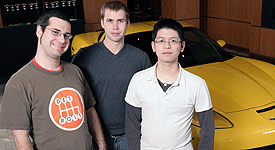Last fall, a team of three University students was among five teams to make the finals of the Chevy Super Bowl College Ad Challenge.
Selected from hundreds of entrants, the team was flown to Detroit and spent days refining its concepts before making a formal presentation to executives from General Motors Corp. and its advertising agency, Campbell-Ewald.

The ad created by the winning team will air Feb. 4 on CBS during Super Bowl XLI — among the most expensive and coveted advertising slots with an audience estimated at 100 million.
The winning team will be announced Feb. 2 during CBS’ “Super Bowl’s Greatest Commercials 2007” special, when viewers will see behind-the-scenes footage of the competition.
WUSTL’s team, known as Chevrolet Team 509, is composed of Hubert Cheung, Shlomo Goltz and Nathan Heigert. Cheung is a senior marketing major in the John M. Olin School of Business. Goltz and Heigert are senior visual communication majors in the Sam Fox School of Design & Visual Art.
“This is a huge honor for the students,” said Frank Oros, associate professor of visual communications, who served as adviser to the team. “It’s also very smart public relations for General Motors. They are clearly targeting a youth audience, and this is a great way for them to differentiate themselves. The contest creates a perception of GM, and Chevy in particular, as a friendly, approachable company that understands young people. It’s really going to help them reach a prime audience.”
The four other final teams came from Elon University in North Carolina, Savannah College of Art and Design, San Jose State University and the University of Wisconsin-Milwaukee.
“We received submissions from across the country and greatly appreciate the creative ideas that students shared with us,” said Ed Peper, general manager of Chevrolet. “These submissions represent the ideas that were most creative and that showed the best understanding of the Chevy brand.”
In Detroit, the finalists spent a hectic weekend being filmed by CBS camera crews as they honed ideas, created storyboards and prepared to make presentations that Monday morning.
“Every waking moment we were wired for sound,” Oros said. “The students’ grace under pressure was awesome. Through constant briefings, public relations events, automobile test drives, grueling all-night brainstorming and creative production sessions — and an anxious final presentation at GM headquarters — they performed like experienced, battle-tested professionals.”
Chevy has begun posting rough animations of some proposed ads (though not yet the finalists) on YouTube.com and the official site for the challenge, ChevyCollegeAd.com.
Other “Webisodes” feature interviews in which students discuss a range of topics, from the key elements of their proposals and the biggest challenge in creating a Super Bowl ad to whether Chevy has taken a risk in launching the competition.
A series of eight online Webisodes about the finalists’ weekend in Detroit airs Jan. 22-Feb. 2 at CBS.com/chevy.
“I think Chevy understands the concept of being adaptive and learning from their consumer base,” Goltz recently explained on the ChevyCollegeAd.com blog. “The risk would be to ignore the trends in culture that are empowering the individual to become better informed and have their word heard.
“I see there being a general movement in advertising towards content influenced by social networking Web sites,” Goltz pointed out. “The Internet has broken down the barriers between consumer and producer and allowed us normal people to be both at the same time.”